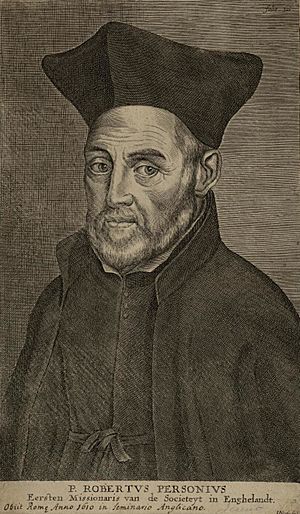Robert Persons facts for kids
Robert Persons (born June 24, 1546 – died April 15, 1610), also known as Robert Parsons, was an English Jesuit priest. He played a very important role in setting up the "English Mission" of the Society of Jesus in the 1500s. This mission aimed to support Catholics in England during a time when their religion was not allowed.
Contents
Early Life and Education
Robert Persons was born in Nether Stowey, Somerset, England. His parents were farmers who owned their own land. A local church leader, John Hayward, helped him get an education. In 1562, Robert started studying at St. Mary's Hall, Oxford, which was part of Oxford University. He did very well in his studies and, by 1568, he became a teacher and helper at Balliol College.
Becoming a Jesuit Priest
While at Balliol College, Robert Persons had some disagreements with the college head, Adam Squire, and also with another priest, Christopher Bagshaw. Because of these problems, he had to leave his teaching job on February 13, 1574.
After leaving Oxford, Robert traveled to Rome, Italy. He was encouraged by another Jesuit priest, Father William Good. On July 3, 1575, Robert Persons officially joined the Society of Jesus and began his training to become a Jesuit priest.
The English Mission: 1580–1581
In 1580, Robert Persons went back to England with another Jesuit, Edmund Campion. Their goal was to support English Catholics who were facing difficult times. The leader of the Jesuits, Everard Mercurian, was at first unsure about sending Jesuits to England. But he was convinced by other church leaders, including William Cardinal Allen.
Persons worked quickly to bring more English people into the Jesuit order. He also planned to work with other Catholic priests in England. However, their mission faced problems right away. The Pope had sent another group to support an Irish rebel, which made the English government very suspicious of all Catholics. This led to stricter rules and taxes for Catholics in England.
Persons and Campion entered England separately. They spent much of their time secretly printing books and pamphlets. These writings explained why Catholics refused to attend the official Church of England services. They moved their secret printing press several times to avoid being caught.
In July 1581, Edmund Campion was captured. Soon after, Stephen Brinkley, who ran the printing press, was also caught. Robert Persons then left England for France and never returned. He had hoped to get the English government to allow public discussions about their beliefs, but this plan did not work out.
Working for the Catholic Cause Abroad
After leaving England, Robert Persons spent the winter of 1581–82 in Rouen, France, where he started writing many books. He worked closely with important French leaders, like Henry I, Duke of Guise. With the Duke's help, Persons started a school for English boys in Eu, France. This school later moved and became Stonyhurst College, a famous school in England today.
Persons was involved in several plans to help Catholics in England, including discussions about who should rule England after Queen Elizabeth I. He also worked with William Allen to study who might be the next ruler. In 1587, Robert Persons took his final vows to become a full Jesuit priest in Rome. He was still in Rome when the Spanish Armada sailed to attack England in 1588.
Later Life and Important Works
Towards the end of 1588, Robert Persons was sent to Spain. He successfully helped smooth things over between the Spanish King, Philip II of Spain, and the Jesuit leader, Claudio Acquaviva. Persons used this good relationship with the King to open several colleges and schools for English students in Spain and Portugal. These included colleges in Valladolid, Seville, and Madrid.
In 1596, while in Seville, Persons wrote a book called Memorial for the Reformation of England. This book described in detail how England could become a Catholic country again. He hoped to become a Cardinal after William Allen died, but he was not chosen. Instead, he became the head of the English College in Rome, where he died at the age of 63.
Robert Persons wrote many important books and pamphlets during his life. Here are a few examples:
- A brief discovrs contayning certayne reasons why Catholiques refuse to goe to Church (1580): This book explained why Catholics should not attend the Church of England services. It was printed secretly in London.
- The first booke of the Christian exercise, appertayning to Resolution (1582): This was a very popular book about how to live a good Christian life. It was reprinted many times and even adapted by Protestants.
- A Conference abovt the next svccession to the crowne of Ingland (1594): This book discussed who should become the next ruler of England after Queen Elizabeth I. It suggested that Isabella Clara Eugenia of Spain might be a good choice.
- A Treatise of Three Conversions of England (1603): In this work, Persons argued against the historical views of John Foxe, who wrote about Protestant martyrs. Persons presented a Catholic view of England's religious history.
Images for kids
-
Page from Robert Persons's anonymous work of 1594 on the future succession to Elizabeth I, discussing Lady Arbella Stuart





